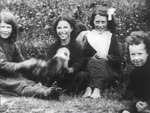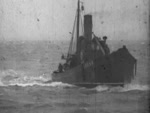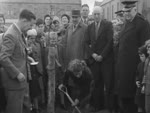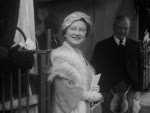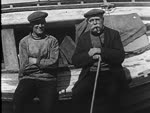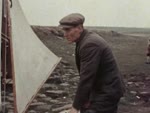WICK SOCIETY KINORA REELS COLLECTION
Video 1 (currently displayed video)
Compliation reel showing all five Kinora Reels (digitally restored) (clip)
Video 2
Herring fishermen 'redding' their nets [no date yet identified] (clip)
Video 3
Two sail drifters entering Wick Harbour [no date yet identified] (clip)
Video 4
Views of Wick Harbour and steam paddle tug 'Marsden' [dated before 1911] (clip)
Video 5
Storm at Wick Harbour [dated sometime after 1897 but before 1911] (clip)
Video 6
Free Mason's Walk for Queen Victoria's Diamond Jubilee [dated 1897] (clip)
Please read Understanding catalogue records for help interpreting this information and Using footage for more information about accessing this film.
Title: WICK SOCIETY KINORA REELS COLLECTION
Reference number: 4627
Date: 1897 - 1910
Director: [filmed by John G. Humphrey?]
Sound: silent
Colour: bw
Fiction: non-fiction
Running time: 2.56 mins
Description:
A collection of five Kinora Reels recording Wick at the turn of the 20th century.
In 1989 a Kinora Viewer together with a collection of reels was given to The Wick Society for display in the Wick Heritage Museum. The reels contained local scenes and events dating between 1897 - 1910. It was originally believed that these reels formed part of The Johnston Collection, also preserved by the National Library of Scotland Moving Image Archive, however we now think that they could be the work of a contemporary local photographer John G. Humphrey.
The National Library of Scotland and the Wick Society started a project in 2009 - the National Library funded the technical work that would lead to digitisation of the reels, and the Wick Society contributed research on the provenance and date of the material.
In March 1897 a Mr. Calder from Aberdeen advertised in the local press the public showing of 'The first living pictures to be shown in the North'. Henry Williamson was approached to be the projectionist. It is also recorded that he invited William Johnston to help him set up and operate the equipment. Subsequent press reports revealed that 'several local views were also displayed evoking much applause'. So popular was the first showing of the 'living pictures cinematograph' that return visits were advertised within weeks to Wick, Lybster and Thurso.
Shotlist:
1. [FISHING BOATS ENTERING HARBOUR]
Two sail drifters entering Wick Harbour (0.34)
[These boats are performing the skilled task of lowering the sail just at the right moment to reduce speed as they enter the harbour. The boats are SY1230 'Annie Smith' [50ft length, skipper A. Gillies, registered in Leurbost, Isle of Lewis] and INS 2412 'Mizpah' [53ft length, skipper John Campbell, registered in Lossiemouth] Both vessels would have been regular visitors to Wick during the summer herring fishery over this time as hundreds of boats and fishermen came from other Scottish ports, the West Coast and the Western Isles]
2. [VIEWS OF WICK HARBOUR]
horse and cart to left of picture, bustling scenes at harbour, fishing boats to right of picture crammed in a line, herring barrels visible beside fishing boats on harbour side. We can see fishermen handling nets as they stand on decks of boat, and men and boys bustling about on harbourside (0.18) fishing boat departs Wick harbour, 'Marsden' steam tug is visible puffing away (0.33)
[The steam paddle tug 'Marsden' can be seen in this footage. It would have been used to tow the sail powered fishing boats out of the harbour and into the bay to catch the wind]
3. [HERRING FISHERMEN DRYING THEIR NETS]
Fishermen 'redding' their nets in Wick Harbour (they stand on boat, pulling large fishing nets onto the deck). This was a daily activity where the nets were hauled over to remove any herring retained in the meshes and left to dry [‘Redding’ or preparing, the fishing line was a lengthy and painstaking job involving the cleaning of hundreds of hooks on the line and then baiting them, often with mussels or lugworms] (0.33)
4. [STORM AT WICK HARBOUR]
Spectacular storm scenes in Wick Bay, iron framed lighthouse and beacon visible on the South Quay, waves crash in to the harbour wall (0.34)
[We know of three original copies of this reel which would suggest the Kinora images were being prepared and distributed as a commercial undertaking]
5. [FREE MASON'S WALK FOR QUEEN VICTORIA'S DIAMOND JUBILEE]
Freemasons walk for Queen Victoria's Diamond Jubilee Parade - we see a line marching out of gate and form two lines facing one another All the men wear top hats. There then is a procession of other men past these lines down the middle. They are dressed in robes and finery, all men. There is a brief shot of a woman and a young boy at RHS of picture, but they quickly pull away out of shot (0.50)
[The local newspapers record a decision of Wick Town Council to hold a United Service in Wick Parish Church on Sunday 21st June, 1897 to mark Queen Victoria's Diamond Jubilee. On the 25th June the paper recorded that 'Wick Town Council, Pulteneytown Commissioner & officials, in their robes of office, marched in procession from the Town Hall to the Church preceded by Mr Calder wearing his uniform and carrying his halberd' Mr John Calder was the Burgh Officer at this time.
Dating this reel is particularly challenging, as the Kinora process did not really emerge until 1906 - 1908. The images contained in this reel may have been compiled from earlier cinematographic material not necessarily captured on Kinora cameras, eg. by Charles Urban Trading Company who offered sales catalogues full of stock footage]

